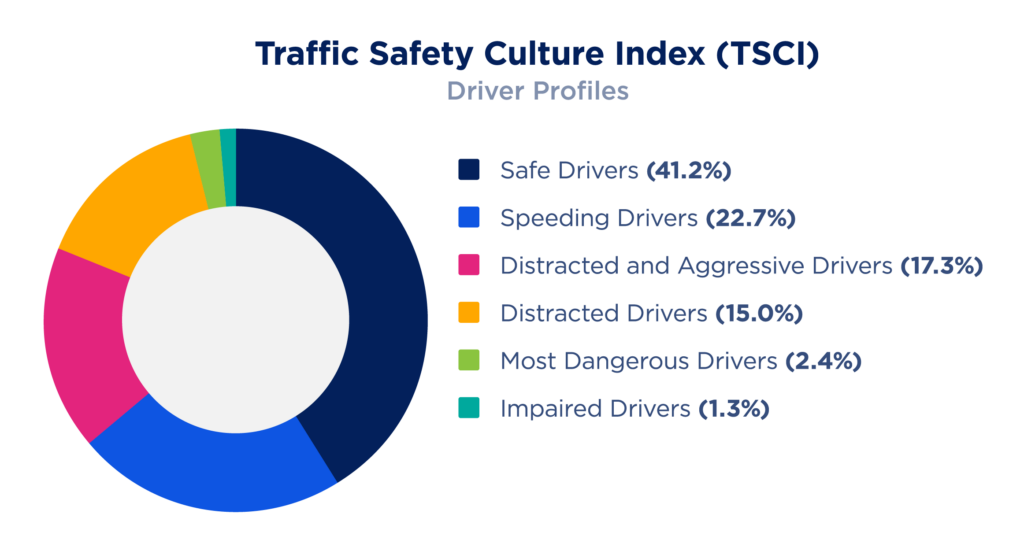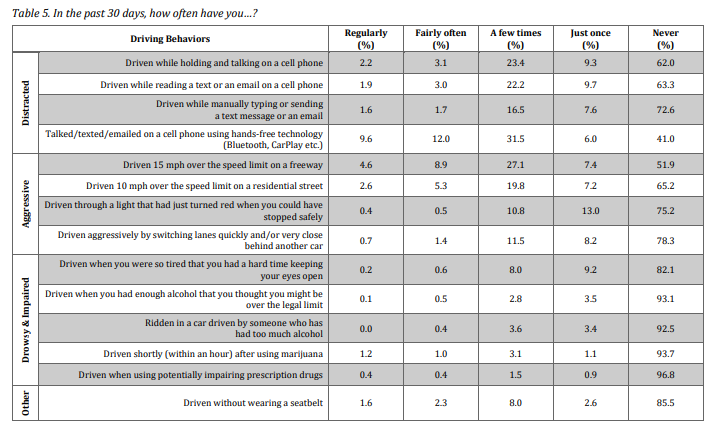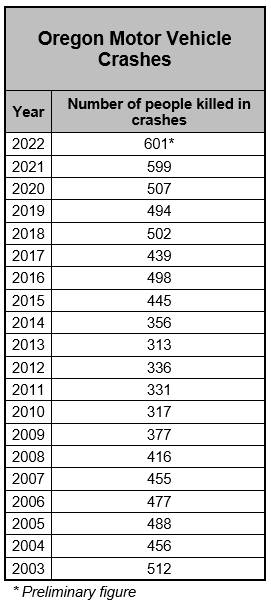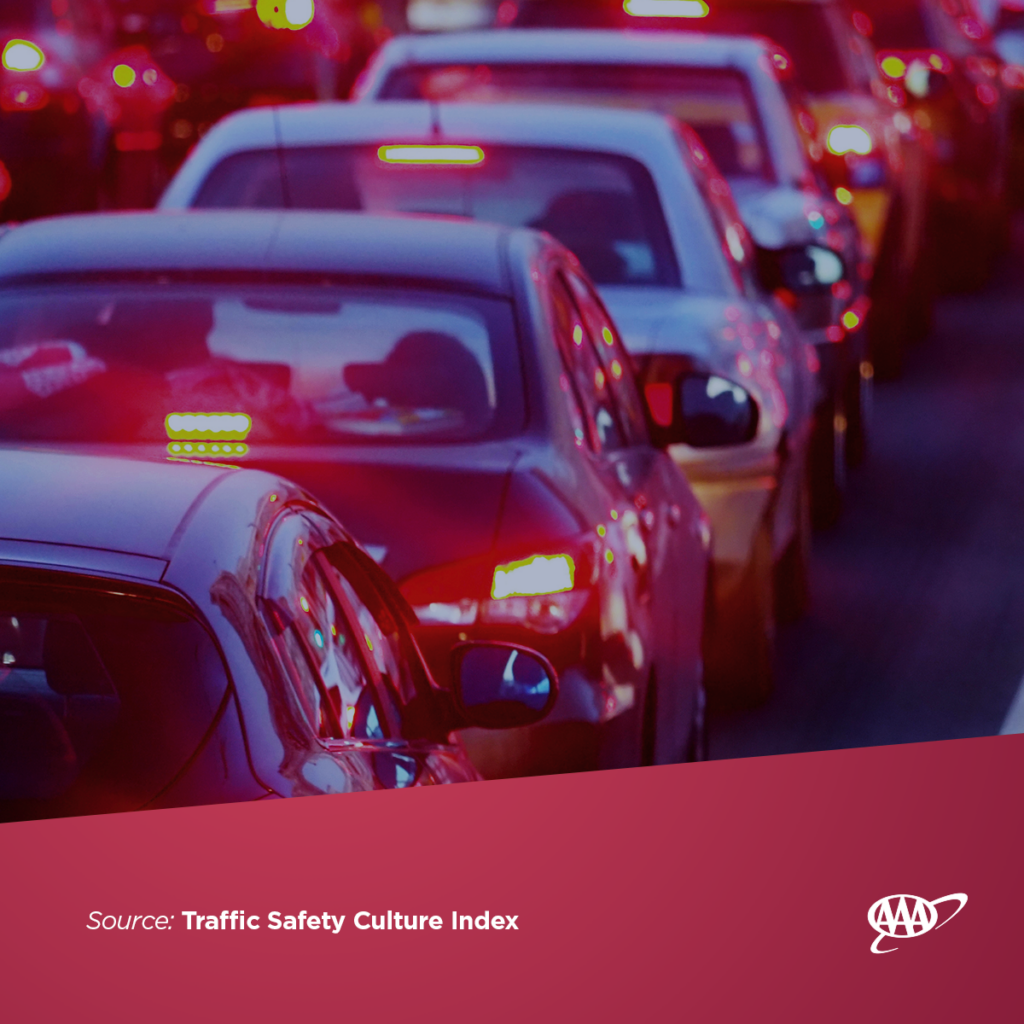New AAA survey finds most Americans are speeding, texting and running red lights
PORTLAND, Ore., – A new report by the AAA Foundation for Traffic Safety shows that nearly 60% of drivers admit to risky driving behaviors such as speeding, distracted driving, and aggressive driving.
The annual Traffic Safety Culture Index survey questioned drivers about their driving habits. Drivers admit to engaging in risky behaviors at least once in the last 30 days. The survey asked drivers about perceived dangers, perceived risk of getting caught, and social disapproval of behaviors such as speeding, distracted driving, aggressive driving, and impaired driving.
The study identifies six types of drivers by analyzing risky driving behaviors. The study developed these six driver profiles by examining patterns of self-reported risky driving behaviors among a large group of drivers. Only 4 in 10 surveyed fall into the “Safe Drivers” category. This group is made up of more women (57%) than men.

Here are the report summary and complete report. B-roll video can be found here:
https://newsroom.aaa.com/asset/red-light-running-b-roll-clip-3/
https://newsroom.aaa.com/asset/red-light-running-b-roll-clip-2/
https://newsroom.aaa.com/asset/speed-limit-signs-broll/
https://newsroom.aaa.com/asset/police-stop-with-teen-driver/
This survey is done every year by the AAA Foundation for Traffic Safety. Since 2008, the annual Traffic Safety Culture Index has examined driver attitudes in the U.S.
“Despite acknowledging the dangers, some drivers continue to engage in potentially deadly behaviors, particularly speeding,” said Dr. David Yang, AAA Foundation for Traffic Safety President and Executive Director. “Understanding the different types of risky driving behaviors and the characteristics of drivers who engage in them is crucial for developing targeted interventions to achieve safe mobility.”
As daily driving patterns and traffic volumes rebound from pandemic lows, traffic fatalities remain alarmingly high. Evidence points to fewer traffic stops, while fatal crashes involving risky behaviors such as impaired driving and speeding remain an epidemic on our roadways.
According to the new Traffic Safety Culture Index (TSCI) report, fewer drivers perceive speeding as dangerous, and speeding behaviors have the lowest perceived social disapproval of all the examined unsafe driving behaviors. It is worth noting, however, that a driver’s need for speed consistently fails to deliver shorter travel times. It would take driving 100 miles at 80 mph instead of 75 mph to shave just 5 minutes off a trip.
“Many drivers think it’s ok to go 10 or even 20 miles per hour above posted speed limits. This study shows that speeding isn’t perceived as being as dangerous as other risky behaviors, but speeding continues to be a major factor in fatal crashes,” says Marie Dodds, public affairs director for AAA Oregon/Idaho. “This study highlights an important opportunity to engage in enforcement that targets speeding drivers, which in turn could deter other risky driving behaviors such as impaired driving and red-light running.”
The six driver profiles identified by the latest Traffic Safety Culture Index (TSCI) are:
Safe Drivers (41.2%) – Few in this group reported engaging in any risky driving-related behaviors, and more women (57%) composed the Safe Drivers group.
Speeding Drivers (22.7%) – These drivers reported driving 15 mph over the speed limit on freeways and/or 10 mph over on residential streets but did not engage in most other dangerous behaviors. About 60% are males.
Distracted and Aggressive Drivers (17.3%) – Reported distracted driving behaviors (texting while driving), speeding, and aggressive behaviors, such as red-light running and switching lanes quickly.
Distracted Drivers (15.0%) – These drivers reported distracted driving behaviors such as reading text messages and texting while driving. About 93% of drivers say texting while driving is dangerous, but 27% admit to having sent a text or email while driving, and 59% say they’ve used a hands-free technology to talk, text or email while driving.
Most Dangerous Drivers (2.4%) – While these drivers consisted of only a small percentage of the drivers, they pose a serious risk to themselves and other road users as they reported engaging in all risky driving-related behaviors. The average age for these drivers is 40, which is about 13 years younger than those in other groups.
Impaired Drivers (1.3%) – Most livein non-metropolitan areas. Interestingly, drivers with a 4-year college degree were far less likely to report driving while impaired. At the same time, the most “over-represented” group consisted of those with some college or an associate degree.
The survey asked drivers about their perceived level of danger for various driving behaviors. The majority of drivers perceived unsafe driving behaviors as very or extremely dangerous, and yet, as in past years, many admitted to doing these behaviors at least once in the previous 30 days.
“There continues to be a real disconnect with drivers – most would not want other drivers to engage in dangerous behaviors, but they think it’s ok if they themselves engage in these risky actions behind the wheel,” adds Dodds.

Crash rates on the rise in the U.S. and Oregon
The number of fatal car crashes has risen over the last several years. The National Highway Traffic Safety Administration (NHTSA) estimates that 42,795 people died in motor vehicle crashes in 2022, about the same as the 42,939 fatalities in 2021 which was the largest number of fatalities since 2005. In 2020, there were 39,007 fatalities.
According to NHTSA, dangerous driving behaviors such as speeding, impairment, red-light running, texting and not using seatbelts account for a considerable proportion of the increased fatalities.
In Oregon, 601 people died in crashes in 2022, according to data from the Oregon Crash Analysis & Reporting Unit, compared to 599 people in 2021 and 507 people in 2020. For 2023, the Oregon year-to-date fatalities as of November 16 are 498. Find more information at the ODOT Crash Statistics & Reports website.

AAA recommends these safe driving tips:
- Comply with speed limits. Drivers tend to overestimate the time saved by speeding. You’d have to travel 100 miles to save roughly 5 minutes, moving at 80 mph instead of 75 mph. Speed kills and isn’t worth the cost.
- Out of sight, out of mind. Stow your smartphone away, turn it to airplane mode, or activate call/text blocking features such as Apple’s Do Not Disturb.
- Only drive sober. If you consume marijuana, alcohol, or use potentially impairing prescription medications, then don’t drive. And if you’re going to drive, then don’t consume these substances.
- Stay alert. Stop driving if you become sleepy because you could fall asleep at any time. Fatigue impacts reaction time, judgment, and vision, causing people who are very tired to behave in similar ways to those who are drunk.
- Buckle up on every ride. A properly worn seatbelt is the most effective way to survive a traffic crash.
The AAA Foundation for Traffic Safety has conducted its annual TSCI survey for over a decade. As traffic safety concerns have escalated, insights from the latest TSCI shed light on public perceptions, attitudes, and engagement in unsafe driving behaviors, offering valuable guidance for developing effective countermeasures. Please refer to the complete report for data collection methodology and limitations.

About the AAA Foundation for Traffic Safety
Established in 1947 by AAA, the Foundation for Traffic Safety is a nonprofit, publicly funded 501(c)(3) charitable research and educational organization. The AAA Foundation’s mission is to prevent traffic deaths and injuries by researching their causes and by educating the public about strategies to prevent crashes and reduce injuries when they do occur. This research informs the development of educational materials for drivers, pedestrians, bicyclists and other road users.
About AAA
Started in 1902 by automotive enthusiasts who wanted to chart a path for better roads in America and advocate for safe mobility, AAA has transformed into one of North America’s largest membership organizations. Today, AAA provides roadside assistance, travel, discounts, and financial and insurance services to enhance the life journey of over 64 million members across North America, including over 57 million in the United States. To learn more about all AAA offers or become a member, visit AAA.com.
AAA news releases, high resolution images, broadcast-quality video, fact sheets and podcasts are available on the AAA NewsRoom at NewsRoom.AAA.com.
Find local news releases at https://oregon.aaa.com/community/media/media-contacts.html
For more info go www.AAA.com. AAA Oregon/Idaho provides more than 890,000 members with travel, insurance, financial and automotive-related services, and is an affiliate of AAA National, serving more than 64 million motorists in North America.

